I’ve just finished hosting my first visitor to Panama! My friend Aurelia and her boyfriend Clayton spent two weeks in Panama at our invitation, and I think they enjoyed themselves fully. It’s the sunny and dry season now in Panama – well, as dry as this tropical country seems to be able to get – and I’m sure coming down here was a welcome respite from the cold of Washington D.C. and even Los Angeles.
Since Decreto 331 one went into effect at the beginning of 2018 and hurt the ability of Uber and other ridesharing drivers to work in Panama, Aurelia got the unintended chance to experience the bus system right away. Thankfully it was a direct bus over the South Corridor toll road, so we were able to escape the far-as-we-could-see traffic on Avenida Domingo Diaz pretty quickly. Arriba was fairly polite to our guest; we’ve noticed that she gets sassy and more hyperactive when there’s lots of human voices talking to each other and ignoring her. It’d been a full day of travel for Aurelia though, so she wasn’t able to stay up late enough to be nipped at too much.
No trip to Panama City can begin without a trip to Casco Viejo, unarguably the main tourist area for the city. The last time I was a tour guide in a foreign city for guests was Jordan 2015, but at least there I could draw upon two years of recalled Arabic to get me around. But this tour guide doesn’t speak Spanish – not well, at least! But since she was able to buy a Panama Hat and haggle prices for tribal artwork on the street, perhaps I did a little better with my muddled translations than I’m giving myself credit for.
The next day, we took “the fancy method” of getting to the city of Colon, on the other side of the country (!!) straddling the Atlantic coast – the Panama Canal Railway. A classic and classy mode of transport to be sure, but I hope that the monthly commuter rail pass is more affordable than $25 each way! I can’t find any documentation on their website that tells me how much that rail pass costs. It’d be astronomically pricey for the average working class Panamanian to be paying $50 a day on transport when a bus between the city and Colon costs 50 cents. I enjoyed the free coffee service and being able to easily step out into the “smoking area” between the cars to watch and listen to the jungle rushing past.
We didn’t spend much time in Colon, just walked up from the train station to the bus station to catch an onward bus to the village of Portobelo, further northeast up the Atlantic coast. As we walked through the squelching mud at the side of the road, we were politely hassled by smiling, English speaking women in tight shirts advertising Colon city tours and local restaurants. I felt bad; we had been told by basically everyone to avoid Colon as much as possible and spend as little time in the city possible. Desperately poor, the city is considered a mugging hotspot for tourists and foreigners, and I’ve heard that in fact, it’s dangerous enough for even locals, that the city pays for thousands of those commuter train tickets for canal workers at the Atlantic port, so that its workers can live in the safety of Panama City but work in Colon each day. If a place is supposedly dangerous enough that workers in its most famous nationalized business have to be shuttled in and out each morning and night, I probably am going to avoid it, just to be safe. But my heart went out to those bravely smiling guides with their laminated cardboard menus of trip activities. I hope there are tourists out there braver than us bringing a bit of tourist money into the city.
This was Aurelia’s first time on a Diablo Rojo, the “Red Devil” school buses that provide the absolute backbone of Panamanian cross-country travel. In the City we’ve got modern air conditioned metro buses that accept RFID payment cards. To go between the major cities you have USA-style coach buses with TVs and bathrooms, or even simple but serviceable white “chiva” mini-buses. But to reach all the myriad tiny villages that sprawl out through the jungle, you look to your last option – the Diablo Rojo. You have to pay with cash, as each bus is independently owned and operated, and while they are amusing to look at with their complicated, detailed, and unique paint jobs, their pollution and lack of safety is legendary. They’re in the process of being phased out throughout Panama City, where there’s a bland and modern Metro Bus being constructed to take each route, but I don’t see how they will ever replace every Diablo Rojo in the country. There’s just too many small villages with people who expect to be able to reach the town over. The local governments are going to casually look the other way when the national government says “so, you’ve gotten rid of all those buses in your district, right?” Unless the Federal administration has suddenly found the money and planning skill to acquire a 1:1 metrobus to diablo ratio, people – both passengers and diablo owner – are flat out not going to accept their routes going away. The painted bus, much like the plastic grocery store bag (which was banned 8 months ago to absolutely zero effect besides the gales of laughter of Panamanians when we foreigners ask about the ban’s status) is going to be around for the foreseeable future.
Where were we? Oh yes, bouncing (literally, to our spines’ extreme displeasure – installing shocks is a sign of weakness to a Diablo Rojo driver) along the narrow, winding coastal road to Portobelo. Dry season or not, the skies were looking drearily overcast (“It’s not supposed to be like this on your vacation; I swear it’s not!”) and the bus was uncrowded; not too many people heading out of the city into the countryside during the weekday work hours. Once we passed the moldering, fungus covered stones of the Spanish Battery on the outskirts of the village, we knew we’d arrived.
We spent a relaxing couple of hours wandering the small city, first looking at the Iglesia de San Felipe, or the Church of Black Jesus as it’s more colloquially called (Aurelia can’t understand much Spanish, but her fluency in French allowed her to puzzle out the sign at the door that said, essentially, that wearing shorts that fell above the knee was prohibited. It wasn’t until after we left that I realized the sign also said that free loaner “dresses” would have been provided at the main office, had we asked!). Afterward, we squelched through the soaked grass of first the east, then west fortresses that had once protected this Spanish port, made to help facilitate the safe, pirate-free transfer of South American gold between carts and ships. The ancient cannons still sat (albeit on the ground, without their original gun carriages; anything wooden in the outdoor climate of Panama is not going to survive more than a decade or two) facing out toward the sea in this perfectly shaped natural port. There were cute little guard towers on most of the corners with gunner’s slits cut in them, which made for good photo ops. After a filling lunch of Old Clothes (ropa vieja, a common Latino dish of stewed vegetables with chewy pulled beef) for me and garlicked shrimp for Aurelia, we were back on another Red Devil back to Portobelo and home.
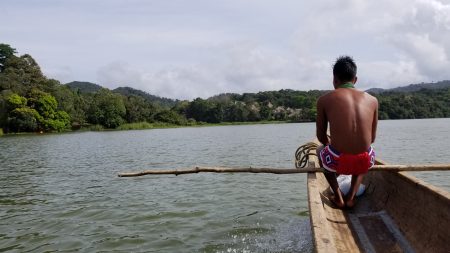
Our little boat’s “punter” is ready to steer us through the narrow back channels of the Changres River
It was finally the weekend, and Christine was able to join Aurelia and I for a trip out to the Embera Village, an hour and a half east of the City. Interestingly enough, Christine had come here when she was 13, on her very first international trip with her school. She was even able to remember a lot of the locations we saw, frozen in that strange kind of twilit memory that we only have for our childhood recollections (but are unable to make again as adults). Sadly, none of us were wearing swim attire, but while Aurelia and I contented ourselves with merely wading into the waterfall pool, Christine decided to go for a full-on swim regardless!
I loved the trip around the Changres River on the carved wooden boats with their outboard motors. The motors were relatively quiet, or the surrounding forest was so dense and dark that it seemed to swallow almost all their sound, and the narrow, shallow boats threw up almost no wake at all. In the village, we were greeted by a group of children and young adults beating drums and playing flutes as we climbed the steps up from the river (Christine would later ask if playing that ceremonious welcome got a bit boring day after day for them – “yes!” was the laughing response). Mateo, a jovial middle aged guide who spoke clear and simple Spanish (which makes sense, as it’s his second language after his native Embera) and a bit of English to us, welcomed us to the guest lodge, presented some of the crafts and tattoo art (called jagua, after the plant it’s made from), then bid us to enjoy a lunch of patacones and deliciously fried tilapia caught mere meters away in the Changres. I’m not usually a fish person but…that was some darn good fish.
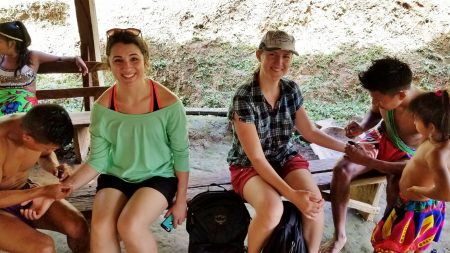
The young men and women of the village are quick to offer a free tattoo (it lasts a week) to all their guests
Christine pointed out that besides the increases in technology (more motors on the boats and cell phones/radios) over the past 18 years since she’d last been here, there had been a culture shift. All of the women had been topless in the village before, same as the men. The men still wore what they had before – a single long, mono-colored loincloth, draped and looped casually (but obviously with expert attention), but while the women before had only worn elaborately colored skirts and let their upper regions be as bare as the men, now it appeared that something had changed their opinion of the female breast, as every woman older than 7 was wearing a glinting, silvery metal covered chest piece. We were all kind of wondering Mateo would mention what cultural shift had happened in the past two decades, but he did not, and we were too shy to ask. On the car ride back later on, we theorized that it could be because all the tourists would now have an easy-sharing digital camera on them, leading to a bit of of a privacy crisis. Or because of the increase in university education for the women; more and more Embera were traveling out of their villages to Panama City for school or other things, and they took back their Western ideas of prudishness with them. Remember, in Panama City it’s technically illegal for even a man to walk around without his shirt on, much less a woman doing so. A step backwards for body freedom, in my opinion, and I hope that it’s more the latter theory. I’d hate it if the only reason these women feel compelled to cover themselves is because tourists are disrespectful assholes and take photos of things that they shouldn’t be.
Really, the only thing we were a little disgusted to see was a small white-faced monkey with a rope around his neck. The white cord was attached to a beam of a house and when he saw us, he started, wide-eyed, then ran in circles and chittered, upsetting a nearby dish of water. Sensitive to culture differences or not, I don’t think any of us were happy to see a wild, non-domesticated primate being held in human captivity with a rope around its neck. None of us said anything, though. What can you say that’s appropriate and tactful in these situations? We’re just tourists passing through an indigenous people’s home for a few hours. Bottom line is that their culture is (apparently?) okay with putting a rope around a monkey’s neck and treating it like a pet. Nothing else we can really do except mention it on our blogs that it was something that we saw, and we didn’t like. If we had complained to Mateo it would have looked like the height of Western snobbery, “Heavens to Betsy, that monkey being on a rope offends my sensibilities! Release it immediately or I shall summon the constabulary!”
Although we didn’t do much during the following day’s sunlit hours (besides lounge by the pool and attend a free neighborhood outdoor salsa lesson led by a very sassy man in orange shoes and marijuana leaves printed all over his pants) it was in the evening that Aurelia and I picked up her boyfriend, Clayton, from the airport. He’d be joining Aurelia for a more adventurous part of their vacation – first to the Panama Canal museum at the Miraflores Lock the following morning, taking a little tour of the Chorillo neighborhood with my friend Victor as our guide, then onward to Valle de Anton, Boquete, and Bocas del Toro. Interestingly, there’s a law for tourists in Panama that states that a guest without a Panamanian drivers license can only drive for the first 90 days of their visa. After that, no driving or car rental for you. Aurelia already had experience driving in Latin America on the little Antilles island of Martinique, but after hanging out with us in Panama City for the past week watching how Panamanians drive (standstill in heavy traffic, with intermittent bursts of deranged speeding in a vain hope to somehow not be in traffic again. It never works, by the way) she was a bit worried about ferrying the four of us across the Canal and into the wilds!
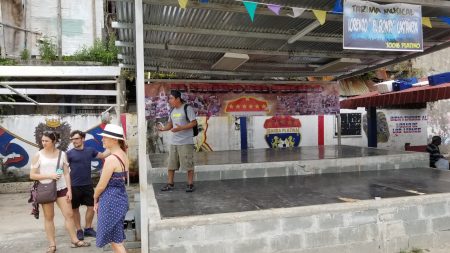
My friend Victor and I volunteer in Chorillo, teaching the local kids some basic English. Here he’s showing us a monument wall to the famous Panamanian futbol players that are from the neighborhood
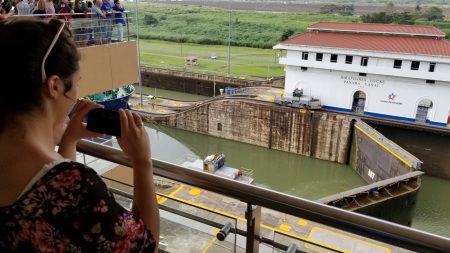
I’d not been to the Museum before, so it was nice to get another perspective on the Canal, since I’d already seen it last year!
Everything went fine, though, besides the usual horrendous afternoon traffic of “everyone attempting to leave Panama City at once through the one highway that goes from the city over the Canal.” When your city is boxed in on half of its sides by the sea to the south and the canal to the west, horrible traffic jams on its single national highway are the norm. But once we were 20-30 minutes outside the city, even though it was dark and the potholes were gigantic, it was an easy, pleasant nighttime drive to the pleasant little town of Valle de Anton. It wouldn’t be until I was taking the bus on my way back two days later that I’d get a chance to see the beautiful mountain vistas we’d been driving next to!
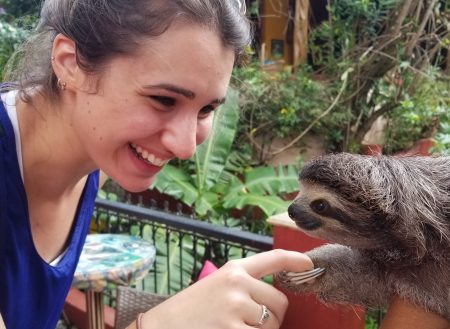
The hotel Aurelia and Clayton stayed at had a few rescued sloths that couldn’t live in the wild. Probably one of my favorite photos I’ve ever taken.
Our goal for the trip was to hike the India Dormida – the Sleeping Indian Girl trail. A popular stop for both locals and tourists, the trail’s admission fee for foreigners was a mere $3 and included not only the beautiful mountain trail itself, but also to see some ancient rock coverings on the face of nearby bluff, and then swim in a shockingly refreshing waterfall fed pool on our way back. The four of us scrambled our way up the slightly muddy trails (we were told later on that this was a seriously uncommon amount of rain for late January) but thankfully, our hiking day saw absolutely perfect weather. Valle de Anton is an ancient extinct volcano: the entire village is built in the slumped and flattened crater itself! This makes for some great views from the lip of the crater that makes up the shape of “the sleeping indian girl” herself. It’s a pretty famous picture so I didn’t bother taking any myself; you can see what the Indian girl looks like from the ground here. It was a great feeling to break above the humid tree line and get the cool, constant mountain breeze hitting you instantly in the face. If we had time, or the expected energy, we could have hiked the full 15km trail that follows the rim of the western part of the crater, but we could see threatening storm clouds moving around in the north so we decided to head back down, pop in the waterfall pool, and get back to the rental car.
The next day, Aurelia and Clayton would be continuing on to cool and spring-ish Boquete (how I envied them the lack of humidity I knew they’d find!) and then afterward, to the surfer’s beach paradise of Bocas del Toro. For Christine and I though, it would be the end of our westward travels; it was time to get on one of the little chiva mini-buses (thankfully, no Diablo Rojos required for our journey back) and head back to Panama City. We could only hope that the little tips and tricks we’d picked up over our 5 months of living here would be of some help!
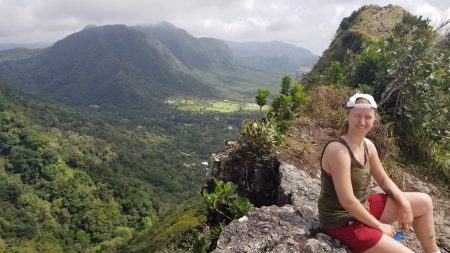
Christine finally has a chance to sit down and relax near the top of the trail. Just another 100 meters to go!
Epilogue: The two of them returned tanned and happy a week later (the day before yesterday) and said that they really enjoyed their trip. They would be staying with us just one last night before catching their respective planes back to D.C. and L.A. the following day. They had some great stories for us which were told over plates of my burritos, but I’ll let Aurelia tell those herself, over at her blog!
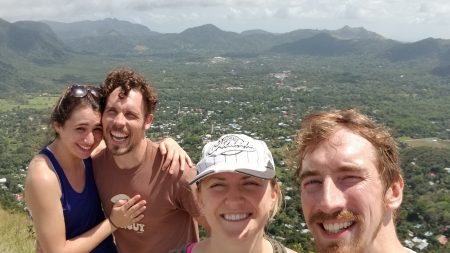
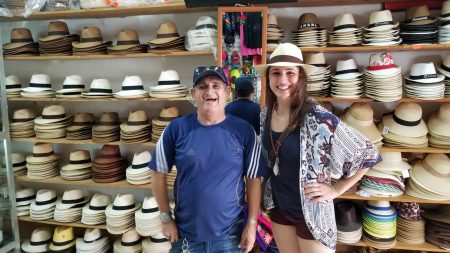
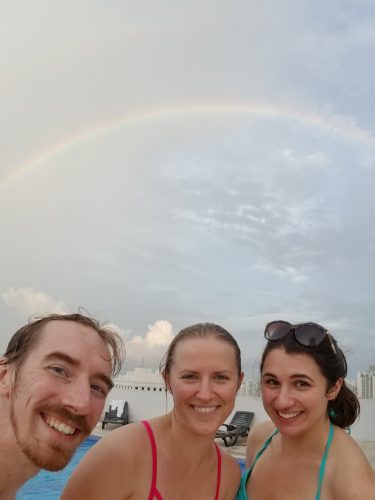
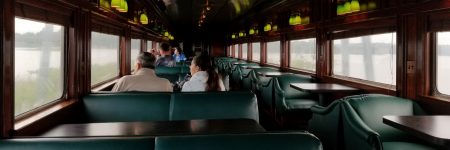
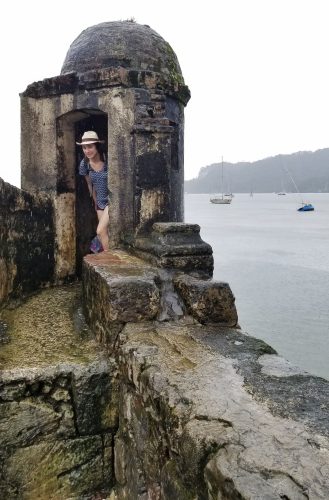
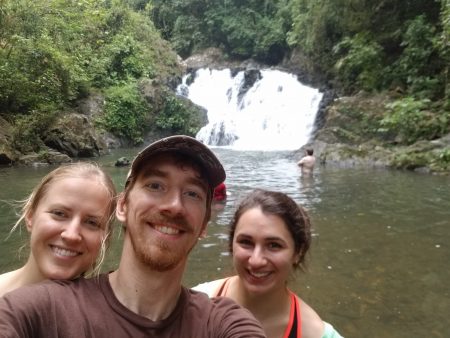
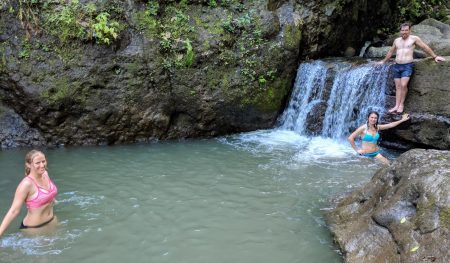


No one has commented on this post - please leave me one, I love getting feedback!
Follow this post's comments, or leave a Trackback from your site